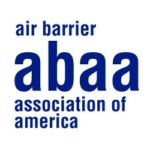What is a Water Resistive Barrier?
A water resistive barrier is a thin membrane, typically 5 to 15 mils thick (.005 to 0.015 in. or 0.13 to .38 mm) which is intended to resist liquid water that has penetrated behind the exterior cladding.
Function of a Water-Resistive Barrier
A properly installed water resistive barrier (which includes proper flashing over doors and windows, continuity at seams, and sealing around penetrations) will improve the overall moisture efficiency and performance of the home or building’s wall system by providing a secondary moisture drainage plane. Water resistive barriers resist bulk water penetration and wind-driven rain that penetrates the exterior cladding from intruding into the wall assembly. Water will be channeled down the outside surface of the water resistive barrier, thus reducing the potential for condensation build-up in the wall assembly which reduces the likelihood of moisture problems, rot and degradation.
Water-resistive barriers come in a variety of widths and lengths as well as a variety of materials. These materials consist of polymeric-based sheets (plastic) and can include spun-bonded (fibers), cross-woven (tapes), film (sheets) or a combination thereof.
A water resistive barrier is different than Grade D building paper (paper-based). Most commercially available polymeric-based water-resistive barriers are highly moisture-resistant and therefore, do not absorb water like typical Grade D or felt building papers. Polymeric water-resistive barrier are typically stronger than Grade D or felt building papers, thus they tend to have better durability than conventional building papers.
Get your water-resistive barrier evaluated and listed with ABAA.
ABAA Evaluated Water-Resistive Barriers
Water-Resistive Barriers Section 072707
Dörken Systems Inc. www.dorken.com
Delta Maxx
| Test Results |
|---|
| Water Vapor Permeance (ASTM E96 – desiccant method) |
| 801 ng / Pa•s•m2 [14.0 US Perms] |
Delta Vent S
| Test Results |
|---|
| Water Vapor Permeance (ASTM E96 – desiccant method) |
| 3941 ng / Pa•s•m2 [68.9 US Perms] |
DuPont Performance Building Solutionswww.weatherization.tyvek.com
Tyvek® CommercialWrap®
| Test Results | |
|---|---|
| Water Vapor Permeance (ASTM E96 – desiccant method) | Water Vapor Permeance (ASTM E96 – water method) |
| 1446 ng / Pa•s•m2 [25.31 US Perms] | 1867 ng / Pa•s•m2 [32.68 US Perms] |
Tyvek® CommercialWrap® D
| Test Results | |||
|---|---|---|---|
| Water Vapor Permeance (ASTM E96 – desiccant method) | Water Vapor Permeance (ASTM E96 – water method) | ||
| 2437 ng / Pa•s•m2 [42.65 US Perms] | 2427 ng / Pa•s•m2 [42.48 US Perms] | ||
Kingspan Insulation LLCwww.kingspaninsulation.com
Kingspan GreenGuard® C2000
| Test Results |
|---|
| Water Vapor Permeance (ASTM E96 – desiccant method) |
| 5377 ng / Pa•s•m2 [94 US Perms] |
Kingspan Greenguard® Max Building Wrap
| Test Results | |||
|---|---|---|---|
| Water Vapor Permeance (ASTM E96 – desiccant method) | |||
| 773 ng / Pa•s•m2 [13.52 US Perms] | |||
Kingspan Greenguard® RainDrop Building Wrap
| Test Results | |||
|---|---|---|---|
| Water Vapor Permeance (ASTM E96 – desiccant method) | |||
| 705 ng / Pa•s•m2 [12.33 US Perms] | |||
Kingspan Greenguard® Value Wrap
| Test Results | |||
|---|---|---|---|
| Water Vapor Permeance (ASTM E96 – desiccant method) | |||
| 692 ng / Pa•s•m2 [12.1 US Perms] | |||
Why Is It Important for Walls to Breathe?
Water resistive barriers are typically vapor permeable, which is generally desirable because it allows for drying of any moisture that accumulates in the wall assembly. Water resistive barriers are manufactured in a range of permeance levels, which allow for a wide range of selection to accommodate various wall designs.
Can You Use Water-Resistive Barriers Under Any Exterior Facade?
Water resistive barriers can be used under most exterior cladding materials. In fact, the International Building, Residential and Energy Codes require the use of water-resistive barriers or felt building paper in exterior walls. There are special requirements for some cladding applications or systems which requires more than one layer of a water resistive barrier. See cladding manufacturers for more information.
How Do I Install a Water Resistive Barrier Properly?
A water-resistive barrier should be installed in accordance with the manufacturer’s installation instruction, consult manufacturer’s literature for further details.
Typically a modified “I” pattern is cut in the water resistive barriers at window openings and the excess material is folded inside the rough opening and attached to a framing member prior to a window being installed. The entire building or dwelling should be wrapped, including corners and gable end walls. Building codes require that all vertical and horizontal seams be overlapped a minimum of six and two inches respectively in a shingle application. Taping of water resistive barrier seams can provide additional protection against moisture intrusion while maintaining durability. However, since taping of seams is not a building code requirement, it is typically considered optional and a good building practice. Refer to ASTM E 2112.
Residential Water-Resistive Barrier Overview & Installation
The Housewrap Committee of ABAA has produced 2 videos to assist building officials and design professionals when using Water-Resistive Barrier materials as a water resistive barrier in homes and buildings. The technical video presentation covers the properties of the material and the installation video covers the key installation criteria.
If you have any questions please contact the ABAA office by email at abaa@airbarrier.org or by phone at 866-956-5888.
